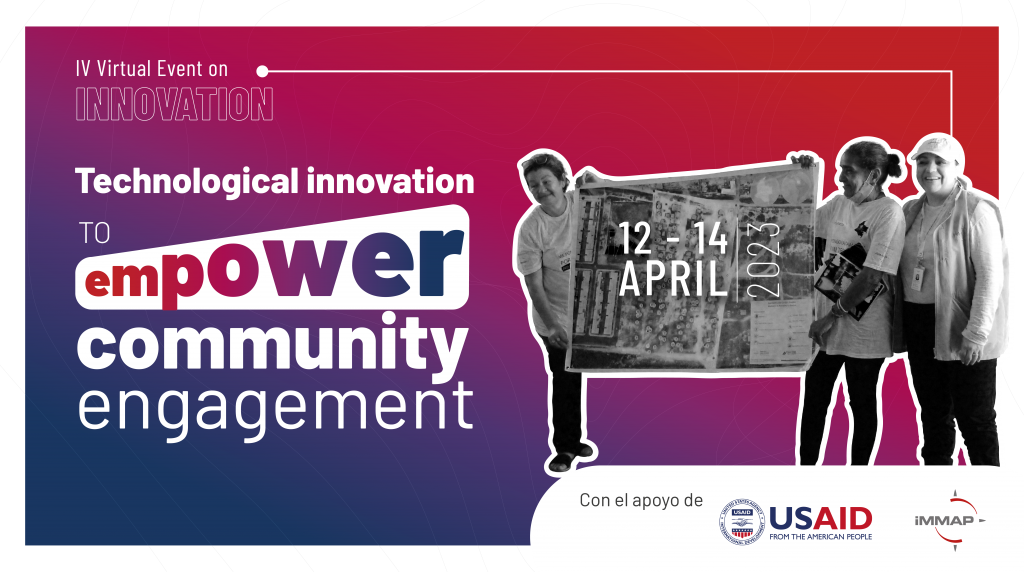For the fourth consecutive year, iMMAP held its annual Virtual Event on Innovation on April 12-14, with the support from USAID’s Bureau of Humanitarian Assistance (BHA). Entitled “Technological Innovation to Empower Community Engagement”, the event aimed to explore the various uses of cutting-edge technology to enhance community engagement and the impact of humanitarian action. Over the course of the three-day event, a series of high-level panellists coming from UN agencies, NGOs, and private sector technology companies shared their insights on technology-fueled solutions – from AI to data crowdsourcing.
iMMAP 4th Virtual Event Explores the use of Innovation and Technology for Improved Community Engagement
With the support from USAID’s Bureau of Humanitarian Assistance, iMMAP held its fourth annual Virtual Event on April 12-14. This year’s theme focused on how innovation and technology can help foster better community engagement.

The virtual event in number:
“Community engagement is the future of information management,” said Jeffrey Villaveces, iMMAP’s Colombia Country Representative, in his opening remarks on the first day of the Virtual Event. By working collaboratively with community groups to ensure that their needs and voices are at the forefront of decision making, humanitarian action would therefore avoid one of its common pitfalls: a lack of localisation. Jonathan Armah, BHA’s Colombia Country Lead, echoed this pressing need by calling for solutions to empower local actors to take the lead in “managing the data and determining what is necessary in their communities” This type of community engagement is at the heart of iMMAP's efforts, as Anjalina Sen of the State Department's Bureau of Population, Refugees and Migration saluted. The way iMMAP works hand-in-hand with local actors is "innovative to begin with, but it also gives ownership and agency back to these communities," Sen said.
While community engagement is now seen as a key component to any humanitarian effort, this has not always been the case. For a long time, local communities were not offered an active role in decision-making processes, nor information gathering. As called by panellist Rania Elessawi of UNICEF, there is a need to finally “acknowledge communities as assets” before moving forward. And, AI may very well be that way forward for the technology-prone humanitarian actors. Brent O. Phillips, of the Humanitarian AI Today podcast, likened the advent of tools like ChatGPT to the invention of the email in opening the doors to better engagement with local actors. However, Phillips argued in his presentation, “ChatGPT: From AOL Age to AI Age”, that we need to “help local communities leverage AI” to explore the full potential of such tools.
With AI at the forefront of general public and humanitarian attention on innovation, the most elementary and fundamental task of information management in the field can also be reinvented through innovative solutions that involve local communities more thoroughly. In this vein, Chris Watson presented the inventive data crowdsourcing methods developed by Premise, where ordinary local citizens are responsible for collecting data on the ground in exchange for payment. Promoting localisation is also high on iMMAP’s agenda in Ukraine, where the team has implemented a bilingual (English and Ukrainian) online training platform to build the skills and knowledge of local actors. During his presentation, iMMAP’s Country Representative in Ukraine, Fridon Japaridze, emphasized the need to tailor capacity building efforts to the local context in order to improve the impact of such community engagement initiatives.
While innovative technology can indeed be a powerful tool to support community engagement, such efforts come with their own set of challenges or “tech traps,” as coined by independent expert Louisa Seferis on the final day of the Virtual Event. First, technology in itself does not improve access; second, technology solutions are not always made for the communities but for the programme needs; third, innovative technology needs accompaniment; and finally, technology alone cannot overcome contextual barriers.




